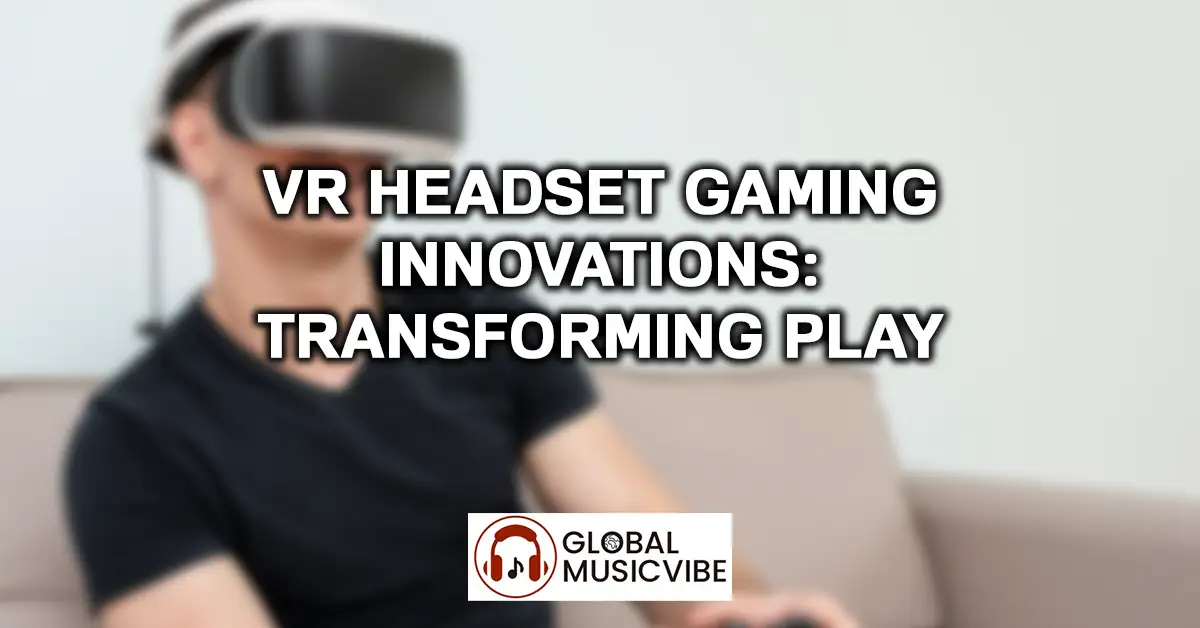VR headset gaming innovations continue to revolutionize how we experience virtual worlds, with groundbreaking technologies making immersive gameplay more accessible and realistic than ever before. From advanced eye-tracking systems to wireless freedom and haptic feedback breakthroughs, the landscape of virtual reality gaming is evolving at an unprecedented pace.
The Evolution of Display Technology and Visual Fidelity
Modern VR headsets are pushing the boundaries of visual clarity with micro-OLED displays and higher resolution screens that eliminate the dreaded “screen door effect” of earlier generations. In 2025, VR headsets deliver ultra-realistic graphics, wireless freedom, and productivity tools that feel like science fiction, with devices featuring better depth tracking, micro-OLED screens, and inside-out tracking systems.
The introduction of pancake lenses has significantly reduced headset bulk while maintaining exceptional optical quality. These innovative lens designs allow for slimmer profiles without compromising field of view, making extended gaming sessions more comfortable than ever. Leading manufacturers have also implemented advanced anti-aliasing techniques and improved pixel density, creating visuals that rival traditional gaming monitors.
Dynamic resolution scaling has become a game-changer for maintaining consistent frame rates. This technology automatically adjusts rendering resolution based on scene complexity, ensuring smooth gameplay even during graphically intensive moments. Combined with advanced upscaling algorithms, players experience minimal visual compromise while enjoying butter-smooth performance.
Eye Tracking and Foveated Rendering Revolution
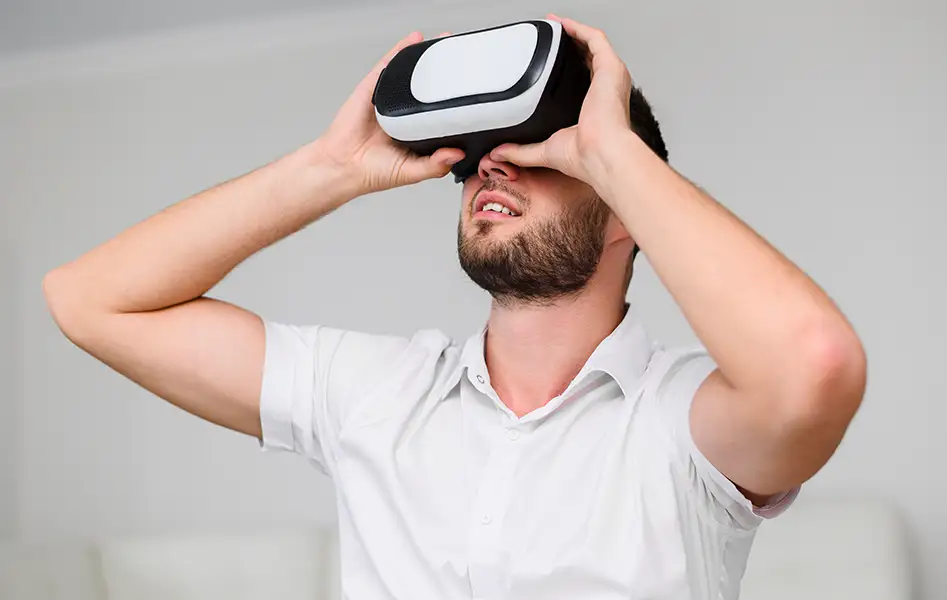
One of the most significant breakthroughs in VR gaming is the widespread adoption of eye-tracking technology paired with foveated rendering. Foveated rendering is a rendering technique which uses an eye tracker integrated with a virtual reality headset to reduce the rendering workload by greatly reducing the image quality in the peripheral vision, allowing the GPU to allocate resources efficiently by rendering high resolution where users are looking and lower resolution in peripheral areas.
This revolutionary approach has transformed performance optimization in VR gaming. Gaming applications enable foveated rendering to make VR games look their best and to never miss a beat because of issues like visual lag, resulting in significant GPU savings for developers. By focusing computational power on the user’s gaze area, modern headsets can maintain higher frame rates while delivering stunning visuals where they matter most.
The implementation of eye-tracked foveated rendering has enabled developers to create more ambitious and visually complex games. Titles that previously struggled to maintain stable frame rates now run smoothly, opening doors for AAA gaming experiences that were previously impossible in VR. This technology has also extended battery life in standalone headsets, as GPUs work more efficiently by not rendering unnecessary detail in peripheral vision.
Wireless Freedom and Latency Improvements
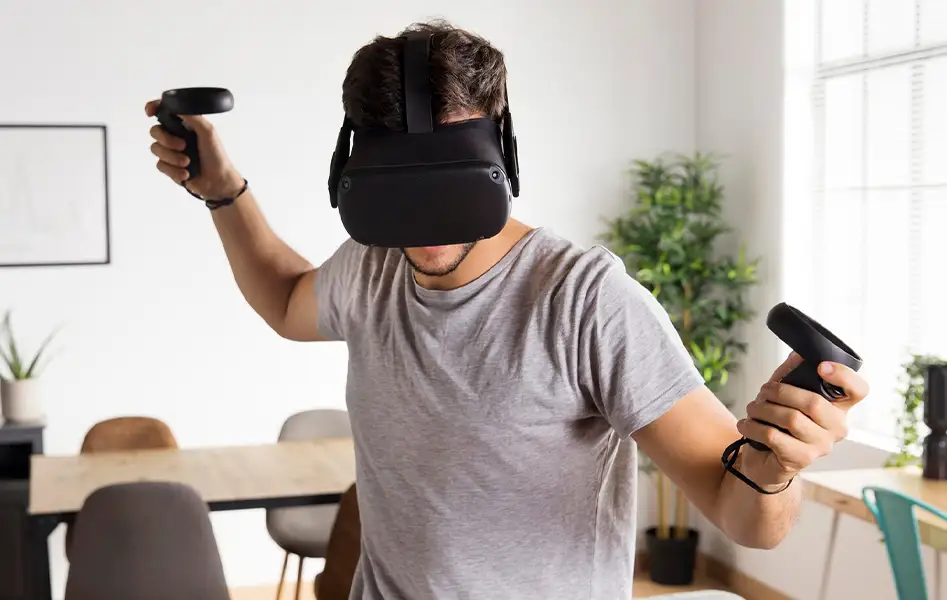
The shift toward wireless VR gaming has accelerated dramatically, with manufacturers addressing the primary concern of latency through innovative streaming technologies. Wireless streaming requires a high-quality Wi-Fi 6 router for optimal performance, with dedicated 5GHz networks and line-of-sight placement minimizing latency. Modern wireless solutions have achieved latency levels that rival wired connections, making cable-free gaming a viable option for competitive players who demand instant response times.
Wi-Fi 6E and emerging Wi-Fi 7 standards have further enhanced wireless VR experiences. These technologies offer increased bandwidth and reduced interference, enabling higher bitrates for sharper visuals without compression artifacts. Some manufacturers have developed proprietary wireless protocols that prioritize VR data packets, ensuring consistent performance even in congested network environments.
The introduction of dedicated wireless adapters with custom compression algorithms has revolutionized PC VR streaming. These solutions maintain visual quality while achieving sub-20ms latency, making wireless play indistinguishable from wired connections for most users. New streaming cables and converters ensure the highest visual quality and lowest transmission latency, with some systems maintaining headset battery levels for all-day PC VR sessions.
Haptic Feedback and Sensory Innovation

The integration of advanced haptic technology has transformed how players interact with virtual environments. 2025 is seeing a continued focus on haptic feedback and other sensory technologies that enhance immersion in VR experiences, with haptic gloves, suits, and even full-body rigs becoming more affordable. These innovations allow players to feel texture, resistance, and impact in ways that dramatically enhance immersion.
Controller haptics have evolved beyond simple vibration to include precise force feedback and texture simulation. Modern VR controllers can simulate the tension of drawing a bowstring, the recoil of firearms, or the sensation of different surfaces. This tactile feedback creates a more intuitive and engaging gaming experience, particularly in simulation and action genres.
Full-body haptic suits represent the cutting edge of sensory feedback, translating in-game impacts, environmental effects, and even temperature changes into physical sensations. While still emerging technology, these suits are becoming more affordable and practical for enthusiast gamers. Some systems even incorporate scent modules and temperature control, creating multi-sensory experiences that blur the line between virtual and reality.
Cross-Platform Integration and Social Gaming
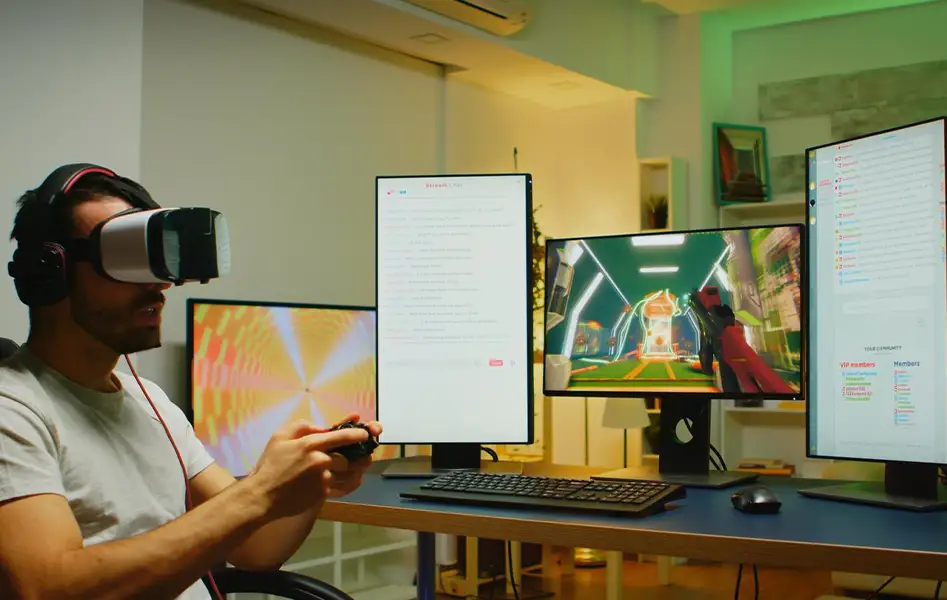
One of the most anticipated AR VR gaming trends in 2025 is the rise of cross-platform play, eliminating barriers between gaming devices and allowing players to connect from different platforms seamlessly. This development has transformed VR from a solitary experience into a social phenomenon, with players on different headset brands and even traditional gaming platforms sharing virtual spaces.
The standardization of development frameworks has enabled this cross-platform revolution. Developers can now create experiences that work across multiple VR ecosystems without extensive platform-specific optimization. This has expanded player bases and encouraged more ambitious multiplayer projects that would have been economically unfeasible when limited to single platforms.
Social VR spaces have evolved into persistent virtual worlds where players can customize their audio experience with compatible headsets while interacting with friends across different devices. These environments support everything from casual hangouts to competitive esports, creating communities that transcend hardware limitations.
Performance Optimization and AI Integration
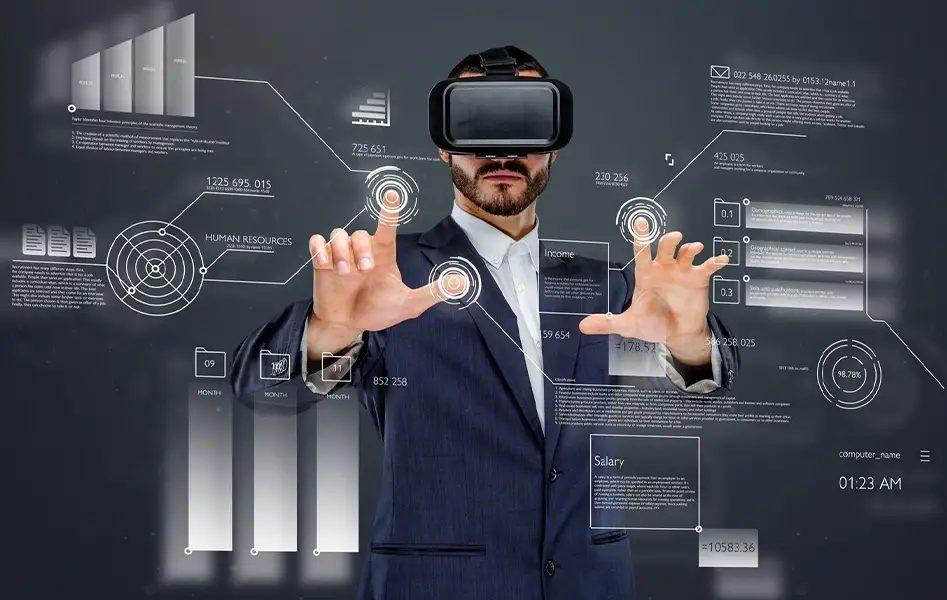
Artificial intelligence has become instrumental in optimizing VR gaming performance. Machine learning algorithms now predict player movements to reduce motion-to-photon latency, while AI-driven upscaling techniques enhance visual quality without increasing computational load. These smart optimizations ensure consistent performance across varying hardware configurations.
Advanced motion prediction algorithms have virtually eliminated motion sickness for many users. By analyzing head movement patterns, modern headsets can anticipate player actions and pre-render frames accordingly. This predictive rendering, combined with higher refresh rates reaching 120Hz and beyond, creates remarkably smooth experiences that feel natural and responsive.
AI also enhances gameplay through intelligent NPCs that respond more realistically to player actions. Natural language processing enables voice-based interactions with game characters, while procedural generation creates infinite variety in game environments. These AI-driven features make virtual worlds feel more alive and responsive than ever before.
The Future of VR Gaming Audio
Spatial audio technology has reached new heights in modern VR gaming, with advanced algorithms creating convincing 3D soundscapes that enhance immersion. Binaural rendering techniques accurately position sounds in three-dimensional space, allowing players to locate enemies by footsteps or navigate by environmental audio cues alone.
Head-related transfer functions (HRTF) have become more sophisticated, adapting to individual ear shapes and hearing profiles for personalized audio experiences. This customization ensures that every player experiences optimal spatial awareness, crucial for competitive gaming where audio cues can mean the difference between victory and defeat. Players seeking to compare different audio solutions can find options specifically designed for VR compatibility.
Real-time audio ray tracing has emerged as a game-changing technology, simulating how sound waves bounce off virtual surfaces. This creates realistic reverb and echo effects that match the visual environment, whether players are exploring vast caverns or tight corridors. The result is audio that feels as three-dimensional and dynamic as the visual experience.
Standalone vs. PC VR Gaming Evolution
The gap between standalone and PC-powered VR gaming continues to narrow, with standalone headsets delivering experiences that rival dedicated gaming rigs. Mobile chipsets designed specifically for VR have enabled console-quality graphics in untethered devices. This democratization of high-quality VR gaming has expanded the market significantly.
Hybrid systems that function both as standalone units and PC-connected headsets offer the best of both worlds. Players can enjoy quick sessions with native applications or connect to their gaming PCs for more demanding titles. This flexibility has made VR gaming more accessible while maintaining options for enthusiasts seeking maximum performance.
Cloud gaming integration represents another frontier, with streaming services beginning to support VR content. This technology promises to deliver high-end VR experiences to modest hardware, though challenges remain in achieving the ultra-low latency required for comfortable play. As 5G networks expand and edge computing improves, cloud VR gaming may become a viable option for mainstream adoption.
Comfort and Accessibility Improvements

Ergonomic design has become a primary focus for VR headset manufacturers, with significant improvements in weight distribution and adjustability. Modern headsets feature balanced designs that reduce neck strain during extended play sessions. Breathable materials and improved ventilation systems address the heat buildup that plagued earlier generations.
Prescription lens adapters and automatic IPD (interpupillary distance) adjustment have made VR gaming accessible to users with vision corrections. These accessibility features ensure that players don’t need to wear glasses under their headsets, improving comfort and field of view. Some systems even include eye-tracking calibration that accounts for vision differences between eyes.
Motion sickness mitigation has seen remarkable progress through various comfort options. Developers now include numerous comfort settings like tunneling, snap turning, and teleportation movement options. Combined with higher refresh rates and improved tracking accuracy, these features have made VR gaming enjoyable for users who previously experienced discomfort.
Developer Tools and Content Creation
The democratization of VR development tools has led to an explosion of innovative gaming content. User-friendly engines and visual scripting systems allow creators without extensive programming knowledge to build compelling VR experiences. This has resulted in a diverse ecosystem of games ranging from indie experiments to AAA blockbusters.
Photogrammetry and volumetric capture technologies have streamlined the creation of realistic VR environments. Developers can now scan real-world locations and objects to create photorealistic game worlds. This technology has been particularly impactful for creating atmospheric experiences where environmental storytelling plays a crucial role.
Procedural animation systems have evolved to create more natural character movements in VR. These systems respond dynamically to player interactions, creating believable reactions and behaviors that enhance immersion. Combined with motion capture data, virtual characters now exhibit lifelike qualities that make social interactions in VR feel genuine.
Frequently Asked Questions
What are the most important VR headset features for gaming in 2025?
The most crucial features for VR gaming currently include high refresh rates (90Hz minimum), low latency wireless capabilities, comfortable ergonomic design, inside-out tracking for easy setup, and eye-tracking with foveated rendering for optimal performance. Resolution should be at least 2K per eye, and having both standalone and PC connectivity options provides maximum flexibility for different gaming scenarios.
How does foveated rendering improve VR gaming performance?
Foveated rendering uses eye-tracking technology to render high-resolution graphics only where you’re looking, significantly reducing GPU workload by lowering resolution in peripheral vision areas. This optimization technique can improve frame rates by 40-50% without noticeable visual quality loss, enabling more complex games to run smoothly on existing hardware while extending battery life in standalone headsets.
Is wireless VR gaming comparable to wired connections for competitive play?
Modern wireless VR solutions using Wi-Fi 6E or dedicated wireless adapters can achieve latency under 20 milliseconds, making them virtually indistinguishable from wired connections for most players. High-quality routers with proper configuration and line-of-sight placement ensure consistent performance. However, some competitive players still prefer wired connections for absolute minimal latency in esports scenarios.
What role does haptic feedback play in VR gaming immersion?
Haptic feedback dramatically enhances VR gaming by providing physical sensations that correspond to in-game actions. Modern controllers offer precise force feedback, texture simulation, and impact sensations. Advanced haptic suits can simulate environmental effects, temperature changes, and full-body impacts, creating multi-sensory experiences that significantly increase presence and immersion in virtual worlds.
Can I play VR games across different headset brands?
Cross-platform VR gaming has become increasingly common, with many titles supporting multiple headset ecosystems. Standardized development frameworks enable developers to create experiences that work across different brands. Popular multiplayer games often support cross-play between Meta Quest, PSVR, and PC VR platforms, though availability varies by title and platform policies.

